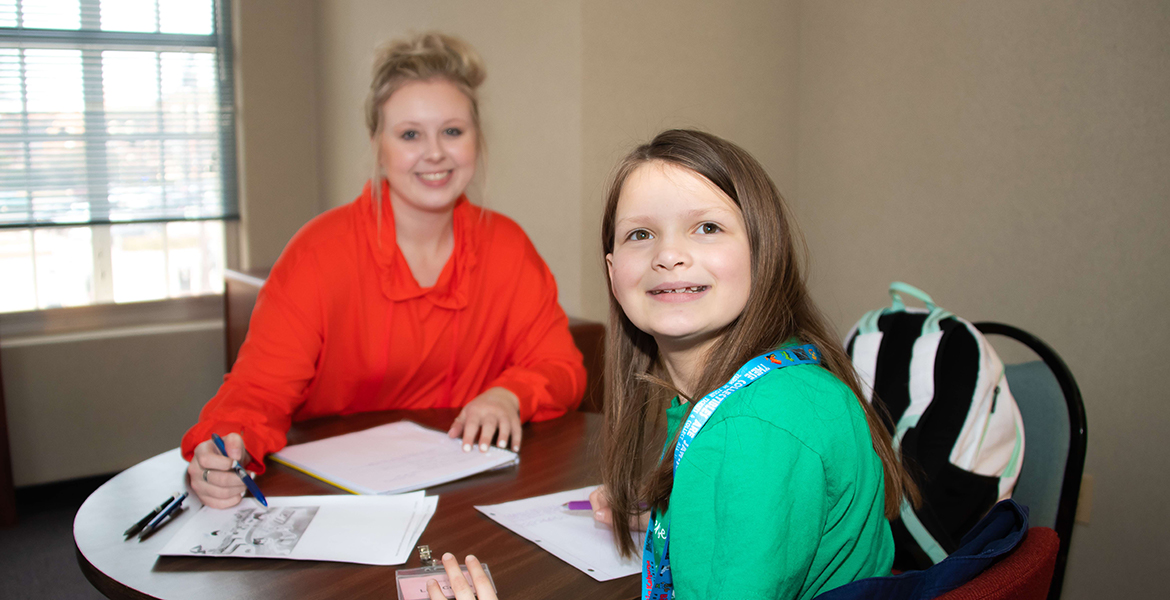
OSU student teachers and tutors adapt to distance learning
Friday, April 17, 2020
Public school buildings across Oklahoma are closed due to coronavirus concerns. For student teachers and education majors teaching and tutoring for the first time, virtual learning is not only their “new normal,” it is their “first normal.”
Student teachers were beginning to transition from observing to leading classrooms, and tutors at the Randall and Carol White Reading and Mathematics Center were at a critical time of building rapport with their tutees when coronavirus concerns emerged, said Dr. Robin Fuxa, director of the Oklahoma State University Professional Education Unit.
“They were a little more than halfway through the semester,” Fuxa said. “They were making good bonds, as any great teacher does. They’re mourning that, of course, but they’ve been incredibly professional and flexible.”
Virtual music
Nearly 170 OSU student teachers are in classrooms across Oklahoma this semester, in addition to 70 education majors tutoring individual students at the Reading and Mathematics Center. Dustin Boatright, a music education student teacher at an elementary school, is one of those students.
“It's hard to do music online because music is such a personal activity,” Boatright said. “You come together, and you move and sing and dance together in one room. That’s what makes it so special.”
However, Boatright said he is determined to provide a positive experience for his students, compiling activities created by other electives teachers into one site complete with music, art and physical education activities. He and his colleagues join other classes’ homeroom Zoom calls to encourage students to utilize the resources.
“I also created a dance called “Wash your hands!” where the kids do hand motions and sing,” Boatright said. “We taught them this dance the day before school was out.”
Boatright keeps in contact with his mentor teacher daily, logs teaching hours while creating online assignments, and attends online seminars hosted by OSU on topics ranging from mindfulness to listening to how an orchestra conductor scores music.
While not an ideal situation, Boatright said he sees the potential for a positive impact on his teaching career as he incorporates more technology into a discipline typically relying on handwritten notes and limited technology.
“There’s no excuse to not get more technology into the music room,” Boatright said of his plans to middle school music in Edmond, Okla., this fall.
Tutoring remotely
Boatright’s success relies on creativity, something Caitlyn Poage, a tutor at the Randall and Carol White Reading and Mathematics Center, is also experiencing.
Poage tutors a seventh-grade student as the lab portion of the Literacy Assessment and Instruction course but is now transitioning to distance learning. Even before coronavirus, her instructor Dr. Sheri Vasinda, associate professor of reading and literacy education in the School of Teaching, Learning and Educational Sciences and one of three instructors of the course, discussed how to lead effective Zoom meetings and required her students to explore two online learning management systems, SeeSaw and FlipGrid.
“We also learned how to use all kinds of Google platforms,” Poage said. “We can use Google Slides, Google forms, all kinds of technologies in our classroom, and our professors teach us how to incorporate them into lessons.”
While some students are working in essential businesses and juggling online tutoring, other students have found more time with remote learning and are using it for professional development. Additionally, since students are now recording online video lessons, they can watch one another’s videos and sharpen their teaching techniques.
“One student is a little bit ahead on her work. I said, ‘You could become a SeeSaw expert for the rest of the class, and there are two other students who I think have time to help you,” Vasinda explained.
While not an ideal situation, Poage sees tutoring at a distance as an opportunity to apply what she has been learning in class before her student teaching experience and one day having a classroom of her own.
“I’m getting to learn about all of these technologies and ways to do this before being put out in the real world and having to figure it out,” Poage said. “I think that’s great.”
Vasinda adds she is encouraged her students have demonstrated flexibility and determination in ensuring their tutees still learn.
“We’re still reaching the mission of the Reading and Math Center,” Vasinda said. “We’re still doing outreach to the community, still helping our students learn how to teach - except in a new way.”
Looking forward
However, delivering lesson plans virtually is not the only challenge OSU student teachers face. Fuxa added senior education majors typically complete final testing for teacher certification and apply for jobs in the spring semester. With in-person gatherings restricted indefinitely, state education leaders have found creative ways to support student teachers.
“We are already receiving video messages from school districts on how to seek jobs at a distance,” Fuxa explained. “One of the superintendents in the area sent a message to all the universities in the area and said, ‘How can we best connect with your candidates now that job fairs are not happening?’”
Teaching interns who have not yet completed their required tests for certification can receive a one-year temporary certificate until they have had an opportunity to complete their exams next year, Fuxa said. Additionally, OSU Career Services has developed special resources for job candidates adapting to an online hiring process.
While the Oklahoma educational system and teaching interns are adapting in unprecedented times, Fuxa is encouraged by the leadership she has seen firsthand.
“Schools have done a really good job of thinking about how to continue to support children’s learning,” Fuxa said. “It’s been interesting to watch how the state has pulled together to support kids and families, and it’s been exciting to see how everyone’s been collaborating with our interns.”
MEDIA CONTACT: Brittany Bowman | College of Education and Human Sciences| 405.744.9347 | brittany.bowman@okstate.edu
